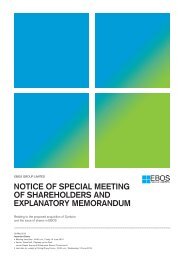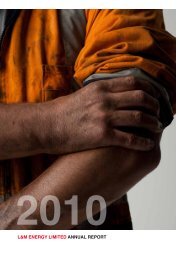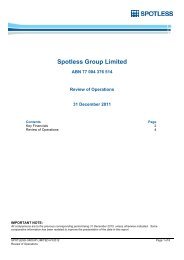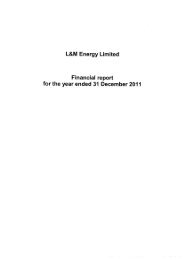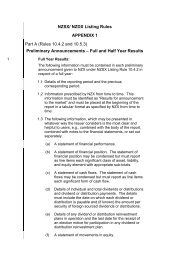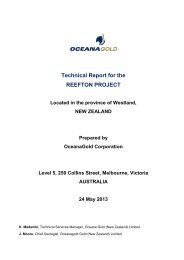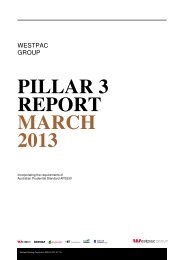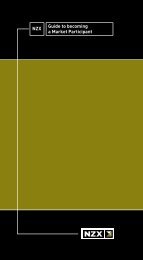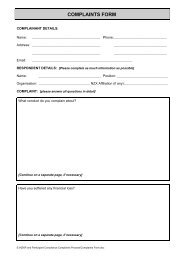Annual Report 2013 - Mainfreight
Annual Report 2013 - Mainfreight
Annual Report 2013 - Mainfreight
Create successful ePaper yourself
Turn your PDF publications into a flip-book with our unique Google optimized e-Paper software.
3 Financial Risk Management Objectives and Policies<br />
The Group’s principal financial instruments, other than derivatives, comprise bank loans and overdrafts, cash and short‐term deposits, intercompany<br />
receivables and payables, director loans, trade creditors and accruals and trade debtors.<br />
The main purpose of these financial instruments is to raise finance and provide working capital for the Group’s operations.<br />
The Group also enters into derivative transactions, principally interest rate swaps. The purpose is to manage the interest rate risks arising from<br />
the Group’s operations and its sources of finance. These are not currently hedge accounted.<br />
The main risks arising from the Group’s financial instruments are cash flow interest rate risk, fair value interest rate risk, liquidity risk, foreign<br />
currency risk and credit risk.<br />
Details of the significant accounting policies and methods adopted, including the criteria for recognition, the basis of measurement and the<br />
basis on which income and expenses are recognised, in respect of each class of financial asset, financial liability and equity instrument are<br />
disclosed in notes 2 and 4 to the financial statements.<br />
Cash Flow Interest Rate Risk<br />
The Group’s exposure to cash flow risk through changes in market interest rates relates primarily to the Group’s long‐term debt obligations<br />
with a floating interest rate. The level of debt is disclosed in note 19.<br />
The Group’s policy is to manage its interest cost using a mix of fixed and variable rate debt. To manage this mix in a cost‐efficient manner, the<br />
Group enters into interest rate swaps, in which the Group agrees to exchange, at specified intervals, the difference between fixed and variable<br />
rate interest amounts calculated by reference to an agreed-upon notional principal amount. With the current low interest rate environment,<br />
particularly in Europe and the USA, the Board decided not to enter into any swaps at this time. At 31 March <strong>2013</strong>, after taking into account<br />
the effect of interest rate swaps, none of the Group’s borrowings are at a fixed rate of interest through to 2014 (2012: nil).<br />
Fair Value Interest Rate Risk<br />
If the Group holds fixed rate debt there is a risk that the economic value of a financial instrument will fluctuate because of changes in market<br />
interest rates. The level of fixed rate debt is disclosed in note 19 and it is acknowledged that this risk is a by‐product of the Group’s attempt<br />
to manage its cash flow interest rate risk. The Group is also exposed to fair value interest rate risk through the use of interest rate swaps. The<br />
Group accepts this risk as a by-product of its hedging strategy. Refer to note 27 for analysis.<br />
Foreign Currency Risk<br />
Foreign currency risk is the risk that the value of the Group’s assets, liabilities and financial performance will fluctuate due to changes in<br />
foreign currency rates.<br />
The Group is primarily exposed to currency risk as a result of its operations in Australia, America, Europe and Asia.<br />
The risk to the Group is that the value of the overseas subsidiaries’ and associates’ financial positions and financial performances will<br />
fluctuate in economic terms and as recorded in the consolidated accounts due to changes in overseas exchange rates.<br />
The Group economically hedges some of the currency risk relating to its Australian operations by holding a portion of its bank borrowings in<br />
Australian dollars. Any foreign currency movement in the net assets of the Australian subsidiaries is partly offset by an opposite movement<br />
in the Australian dollar loan. In addition the Group has loans in United States (US) dollars to assist in funding its US operations and to offset<br />
the variability of future post interest financial performance to foreign exchange rate fluctuations. In addition the Group has loans in Euros to<br />
assist in funding its European operations and to offset the variability of future post interest financial performance to foreign exchange rate<br />
fluctuations. These foreign currency borrowings are held in Australian, US and New Zealand entities respectively.<br />
Included in bank term loans at 31 March <strong>2013</strong> is a borrowing of EU€113,000,000 (2012 €110,000,000) which has been designated as<br />
a hedge of the net investments in the European subsidiaries, the Wim Bosman Group. It is being used to hedge the Group’s exposure to<br />
changes in exchange rates on the value of its net investments in Europe. Gains or losses on the retranslation of this borrowing are recognised<br />
in other comprehensive income to offset any gains or losses on translation of the net investments in the subsidiaries. A net after tax gain on<br />
the hedge of the net investment of NZ$4,927,468 (2012 $8,533,980) was recognised in other comprehensive income for the period.<br />
Financial Statements<br />
83



